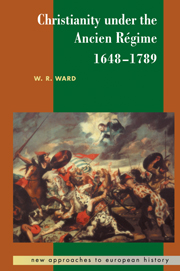Book contents
- Frontmatter
- Contents
- List of maps
- Preface
- Glossary
- 1 Peace and conflict: church and state in central and north-western Europe
- 2 Christianity in southern Europe
- 3 Catholicism in the Holy Roman Empire and the eastern Habsburg Lands
- 4 The religion of Protestants
- 5 Revival moves to the west
- 6 The Enlightenment and its precursors
- 7 The Churches in northern and eastern Europe
- 8 Religion after the Seven Years War
- Suggestions for further reading
- Index
- Title in the series
7 - The Churches in northern and eastern Europe
Published online by Cambridge University Press: 05 June 2012
- Frontmatter
- Contents
- List of maps
- Preface
- Glossary
- 1 Peace and conflict: church and state in central and north-western Europe
- 2 Christianity in southern Europe
- 3 Catholicism in the Holy Roman Empire and the eastern Habsburg Lands
- 4 The religion of Protestants
- 5 Revival moves to the west
- 6 The Enlightenment and its precursors
- 7 The Churches in northern and eastern Europe
- 8 Religion after the Seven Years War
- Suggestions for further reading
- Index
- Title in the series
Summary
Muslim and Christian
The fate of organised religion in eastern Europe was intimately connected with the dramatic rise and fall of empires. The Ottoman Empire, as we have seen, had been pushed back and beaten into permanent decline by the Habsburgs (with Polish and Venetian assistance) by the time of the Peace of Carlowitz of 1699. But that decline was uncommonly slow; the Turks thrashed the Russians in 1711, recovered territory from Venice in 1718 and from Austria in 1739, securing the line of the Danube and the Sava which lasted till 1914. The effect of this was to expose the Protestants of Hungary to the most savage and unsuccessful onslaughts of the Counter-Reformation, and to leave the Christian communities still under Ottoman rule in variegated and often ambiguous positions. In some areas such as Bosnia and much of Albania the population had been converted wholesale to Islam. Moldavia and Wallachia remained Christian and largely autonomous; they paid tribute to the Sultan and were governed after a fashion by hospodars who from the early eighteenth century were always Greeks from Constantinople. The Aegean islands were governed less oppressively than any other part of the Empire, and many Greek communities were almost independent. The recovery of the Morea from Venice in 1718 was assisted by the dislike of the Orthodox population for their intolerant Catholic masters.
- Type
- Chapter
- Information
- Christianity under the Ancien Régime, 1648–1789 , pp. 202 - 224Publisher: Cambridge University PressPrint publication year: 1999

